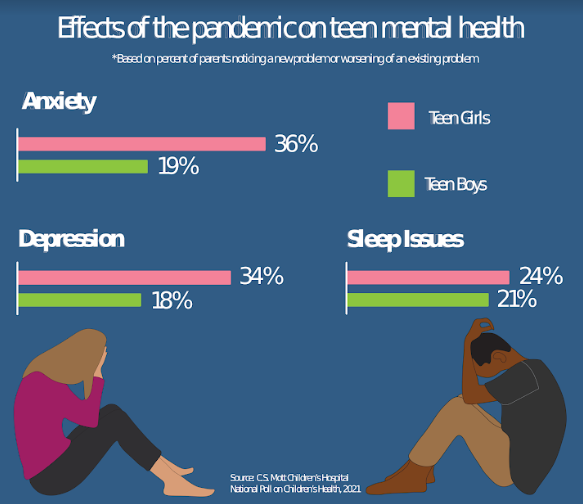Rise in Mental Health Issues Among Teens

Graphic by Alexandria Valencia
December 19, 2022
Since the beginning of the pandemic, life has changed dramatically for many and issues like social isolation and financial pressure became prevalent, according to Mayo Clinic. With COVID-19 came the onset of depression, anxiety, and isolation, among other mental health issues, in teens according to the World Health Organization. Cut off from their friends, from school, and their life, many teens lived the past few years in isolation. For someone who has not lived for very much of their life, a reference of what is “normal” and what is not, does not seem very apparent, according to counselor and Associate Professor at the University of Mary Hardin Baylor Jason Martin.
“If you’re 15 years old, a year and a half is 10%, that’s a long time,” Martin said. “So 10% of your life is of a particular way, and it’s the most recent 10% of your life, then it’s going to be hard to really put yourself back into the mindset of what life was like before that time.”
According to the Center for Disease Control (CDC), mental health from before the pandemic is vastly different from how it is now. There’s been an exacerbation of isolation and lack of ability for development according to LASA wellness counselor Olga Alvarado.
“There was a lot of isolation,” Alvarado said. “Some things that you go through navigating relationships, peer issues, all of that and navigating the ability to talk to other people, that just got cut off.”
Counselor Kathryn Fisher said the age in which teens had to take a step back, was a time full of vital developmental and critical moments. She believes that teens were taken away from society at a period where their brains were beginning to take shape.
“As a teen, the part of your brain (prefrontal cortex) that controls executive function, emotion regulation, impulse control, decision making, et cetera is still forming,” Fisher said. “The pandemic happened at a time when teens were/are growing this brain muscle and they were flooded by unregulated emotions from internal and external factors. The prefrontal cortex wasn’t yet equipped to regulate this flood.”
The chance to connect and develop has been taken away from teens, according to Alvarado. Despite this, the conversation about mental health has seized the chance to evolve with an emergence of awareness.
“It’s becoming less of a stigma, so if you have mental health issues, or difficulties, if you see a counselor, you see a therapist, that’s much less stigmatizing than it was a few years ago,” Martin said. “It’s much more normal, and it’s more acceptable and even healthy, to see a counselor and to talk to people about your mental health.”
The progress of mental health has grown alongside the newest generation. Alvarado partially credits the evolution to social media.
“The impact has been shown a lot on different platforms because I know the one thing that has been really coming up, especially working with the teen population, is that you will post a lot of this stuff [mental health related content] on Tik Tok,” Alvarado said.
Seeing people be more open about mental illness on social media, and influencers’ attempting to destigmatize getting help for mental illness is one of the positives that has come from the pandemic. With social media, there are also negative effects that will continue to play out, according to Martin.
“Looking to see how the continued evolution of social media continues to affect how people think of themselves,” Martin said. “I think we’ve seen a lot of evidence that it can have a positive effect if social media allows people to connect with people who are encouraging and supportive, but it can also have a negative effect, if it amplifies insecurities and amplifies hostile behavior.”
The destigmatization of mental health has opened up the floor for people to be open with their struggles and seek help. Fisher says that this sparked through both organic means like social media and strategic means from campaigns.
“In either instance, there have been more opportunities to connect with others that are also struggling who might otherwise have felt alone or abnormal,” Fisher said. “People finally feel seen and now they want to be heard and heal.”
Going from interacting with hardly anyone to being back to a seemingly normal life, prompted an odd adjustment. Alvarado said she observed an increase in a struggle to adapt back to life.
“There was an increase just in mental health for students, just not knowing how to reengage or socialize again, and just feeling more anxious and more nervous,” Alvarado said.
While there has been an adjustment in getting back to normal and experiencing an event such as the pandemic, a different kind of attitude has formed. Fisher says that on the other side of negative feelings there has been an emergence of curiosity, resilience and perseverance.
Martin said one of the ways to take care of yourself is by taking care of your mental health and seeking counseling.
“There’s no downside to it [counseling],” Martin said. “If someone is thinking about it, looking into it, the first thing I would recommend is just do it. Have one session. You’re not committing to going every week, for a year, or anything like that.”
The effects of the pandemic could be long lasting, but they’re not something that is easily identifiable at this point in time. Short term effects are already being revealed as Dr. Martin points out that some people may have new fears of large crowds and spaces after having been confined for so long.
Mental health is something serious and necessary to consider, according to the CDC. Therapists are there to listen, and counseling gives a space to talk in times of distress.
“You might not connect with the first therapist. That’s ok,” Fisher said “Try again. Your future self will be so grateful.”

